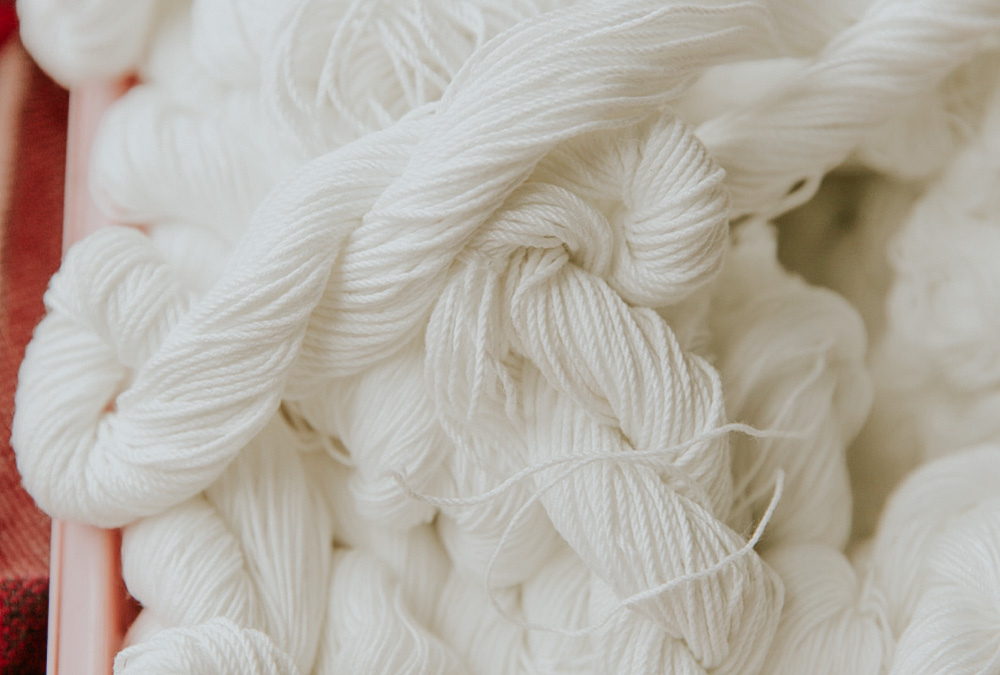The types of yarn you choose for your projects are the most important parts of your crafting experience. Yarn is a crucial part of any fiber art or craft because you will constantly touch the tread working on your project. And if you do not like how it feels, you are more likely to put whatever you are doing aside and forget about it. No matter how beautiful the design or the pattern is. On the contrary, if you like the feeling of the yarn in your hands, you will be eager to return to your work as soon as possible and finish it.

Yes, there is something unexplainable about the peace and serenity in touching the yarn during knitting and crocheting. But each yarn is not only about how it feels on touch! Otherwise, there will be just a few kinds in many colors. Here are a few things you need to consider when choosing the types of yarn for your project. For your first one especially.
Allergies and intolerances of your skin

Fun fact: my first project was a baby blanket for my Sofia while I was due in February. Thus I bought beautiful soft wool in the yarn store considering just the yarn weight and hook number specified in the pattern. A few hours later I was sneezing and coughing, and my eyes were red and swollen. If you have the same “symptoms” stop immediately and opt for another yarn. N.B. I tried 5 different kinds of yarn for this project before I found the one that did not make me sick.
I love looking at beautiful fluffy garments in angora, alpaca wool, mohair, and other “hairy” yarns, but I can neither wear nor use them for my projects. Merino wool is hypoallergenic and there are many varieties of colors, weights, and textures. I am eagerly working with it for my winter blankets and garments.
Stitches of the pattern

This might seem weird to you, but I think that big-weight yarns like chunky, super chunky, bulky, super bulky, and jumbo are ideal for the very basic stitches. They stand out in very simple patterns like stockinette stitch or single/double crochet stitch patterns. And get lost in the intricate and complicated stitch combinations.
The more “complicated” or lacy the stitches combination is, the thinner yarn will work best for it.
Flexibility and ability to keep the form

Wool and acrylic yarns are more flexible and are keeping the original form of the garment after washing it more easily than cotton, linen, and some other yarns. If the design you are making needs to “fall right” to fit and to be soft and flexible (like a sweater), it is better to choose wool or fiber that contains wool.
On the other side, if you are making a rug, bag, lamp, or any other home decor piece you will need a different kind of yarn than for a blanket or clothes. The yarn for home decor needs to be more sturdy and resistant.
Washing and care

For all the handmade items I always recommend handwash. Sometimes even for the yarns that have a machine wash sign on the label. There are also many types of superwash yarns that went through a particular treatment to be sure that they won’t be destroyed in the washing machine. So ask yourself how important is to you the fact that you will have to handwash. If it is important to you, invest in super-wash yarn. It is absolutely worth the extra money!
Natural or modern synthetic fibers

There is a myth that natural yarns are the best for the skin, softer on the touch, etc. Yes, they are, As well as many other options on the yarns market. For many years I was choosing only natural yarns to work with believing that they will be the best for the baby. Having a baby shop I had many requests to do my winter blankets not in wool. I made years of research and tried many different yarns. And guess what? I found a valid substitute (warm, chunky, and very soft) in the combo of cotton and acrylic yarn of high quality. This is how my “No Woolly” collection was born. More about it you can read here.
Industrial, handmade, or artistic

Personally, I believe this does not matter! Try any of them and find your favorites. Combining classic yarn and artistic one in your project can give it extra sparkle and make it so special.
You have probably heard many times jokes about yarn addiction. Or have seen on Instagram photos and videos of beautiful shelves filled with hundreds of different yarns. For someone who does not knit and crochet (yet :)) it might seem too much. But very soon after you start knitting and crocheting you realize that, indeed, there can never be too much yarn :).
The most beautiful thing about this “addiction” is that you never stop learning and discovering. It’s like a complete Universe to explore!
So tell me – what are your favorite yarns to work with? Please share in the comments below.